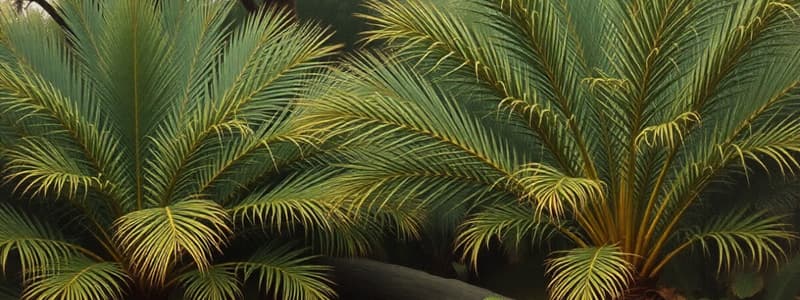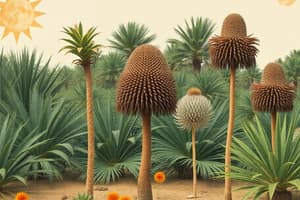Podcast
Questions and Answers
What characteristic distinguishes male Cycadales plants from female ones?
What characteristic distinguishes male Cycadales plants from female ones?
- Female plants produce cones.
- Female plants have more leaflets than male plants.
- Male plants show a higher height growth compared to female plants.
- Male strobilus cone is borne at the apex of the trunk. (correct)
What is the function of the thick, leathery leaflets of Cycadales?
What is the function of the thick, leathery leaflets of Cycadales?
- To attract pollinators.
- To conduct photosynthesis. (correct)
- To provide structural support.
- To store water.
Which type of root is NOT found in Cycadales?
Which type of root is NOT found in Cycadales?
- Coralloid roots.
- Fibrous roots. (correct)
- Tap roots.
- Apogeotropic roots.
What type of reproductive structure is characteristic of female Cycadales plants?
What type of reproductive structure is characteristic of female Cycadales plants?
What is the primary composition of the male strobilus in Cycadales?
What is the primary composition of the male strobilus in Cycadales?
How do coralloid roots of Cycadales interact with their environment?
How do coralloid roots of Cycadales interact with their environment?
Which characteristic of the leaves of Cycadales helps protect the shoot apex?
Which characteristic of the leaves of Cycadales helps protect the shoot apex?
What is the average height range of Cycadales plants?
What is the average height range of Cycadales plants?
What is the typical growth pattern of Cycadales leaves?
What is the typical growth pattern of Cycadales leaves?
What is the arrangement of leaflets on the leaves of Cycadales?
What is the arrangement of leaflets on the leaves of Cycadales?
Which type of root system is specifically mentioned in relation to Cycadales?
Which type of root system is specifically mentioned in relation to Cycadales?
What is the structure of male reproductive organs in Cycadales?
What is the structure of male reproductive organs in Cycadales?
How do female Cycadales plants reproduce?
How do female Cycadales plants reproduce?
What kind of relationship do coralloid roots have with specific microbial species?
What kind of relationship do coralloid roots have with specific microbial species?
What is the texture and shape of the leaflets in Cycadales?
What is the texture and shape of the leaflets in Cycadales?
How is the height of the tallest Cycadales species characterized?
How is the height of the tallest Cycadales species characterized?
What primary type of reproduction do Cycadales plants exhibit?
What primary type of reproduction do Cycadales plants exhibit?
What shape is the leaf base of Cycadales leaves?
What shape is the leaf base of Cycadales leaves?
Flashcards
Cycadales Structure
Cycadales Structure
Cycads are low, palm-like plants (4-20 feet tall) with unbranched, columnar stems covered by persistent leaf bases. Their reproductive structures are unique; female structures do not form cones.
Cycad Leaves
Cycad Leaves
Cycads have pinnately compound, megaphyllous leaves with many leaflets arranged on a central rachis. Leaflets are photosynthetic, thick, and leathery..
Cycad Roots
Cycad Roots
Cycads have both normal taproots and unique apogeotropic coralloid roots. Coralloid roots are a distinctive feature resembling coral.
Cycad Symbiosis
Cycad Symbiosis
Signup and view all the flashcards
Cycad Reproduction (Male)
Cycad Reproduction (Male)
Signup and view all the flashcards
Cycad Reproduction (Female)
Cycad Reproduction (Female)
Signup and view all the flashcards
Dioecious Cycads
Dioecious Cycads
Signup and view all the flashcards
Cycad Size
Cycad Size
Signup and view all the flashcards
What is a cycad?
What is a cycad?
Signup and view all the flashcards
Cycad morphology
Cycad morphology
Signup and view all the flashcards
What are coralloid roots?
What are coralloid roots?
Signup and view all the flashcards
Cycad sexuality
Cycad sexuality
Signup and view all the flashcards
Cycad male cone
Cycad male cone
Signup and view all the flashcards
Cycad female reproduction
Cycad female reproduction
Signup and view all the flashcards
How big are cycads?
How big are cycads?
Signup and view all the flashcards
Why are cycads called 'living fossils'?
Why are cycads called 'living fossils'?
Signup and view all the flashcards
Study Notes
Gymnosperms - Cycadales
- Gymnosperms belong to four phyla: Coniferophyta, Cycadophyta, Ginkgophyta, and Gnetophyta.
- Cycadales is an order within the Cycadophyta phylum.
- Cycadales are commonly known as cycads.
- Cycads originated from seed ferns (Cycadofilicales) during the Carboniferous period and were dominant vegetation during the Triassic period of the Mesozoic era.
- The order includes eleven living genera and about 370 species.
- Most cycads are woody trees, except for Zamia pygmaea.
- Stems are mostly unbranched and covered with persistent leaf bases.
- Leaves are arranged in whorls at the stem apex and are pinnately compound.
- Wood is monoxylic.
- Micro- and megasporophylls typically develop on male and female strobili.
- Cycads are low and palm-like, typically 4-8 feet tall.
- Tallest species can reach up to 20 feet.
- Stems are unbranched, columnar, and covered with persistent leaf bases.
- Female reproductive structures (megasporophylls) are not aggregated in cones.
- Ovules (two or more) are on the lower margins in ascending order.
- Plant shows tuberous stems when young, progressing to a columnar and unbranched stem.
- Leaf-shoot apex is protected by a rosette of brown scale leaves.
- Plants grow slowly, adding a new crown of leaves every 1-2 years, alternating with scale leaves.
- Leaves are pinnately compound megaphyllous leaves with 80-100 pairs of leaflets on the rachis.
- Leaf bases are rhomboidal in shape, attaching the leaf transversely to the stem.
- Leaflets are thick, leathery in texture, ovate or lanceolate in shape, and photosynthetic.
- Scale leaves are very small, rough, and dry, triangular in shape, and brown in color.
- Roots are of two types: normal and apogeotropic coralloid.
- Normal taproots grow from the radicle deep into the soil, producing lateral branches.
- Some lateral roots grow apogeotropically towards the soil surface and branch dichotomously.
- These roots are short, thick, and swollen at the tips.
- Coralloid roots appear coral-like on the soil surface.
- They do not bear root caps.
- The cluster has lenticel-like apertures.
- Roots become infested by N2-fixing blue-green algae (cyanobacteria), bacteria, and diatoms.
- Examples include Nostoc punctiforme and Anabaena cycadacaerum.
- Symbiotic relationships are thus established.
- Vegetative reproduction occurs via bulbils developing in crevices of scale leaves and leaf bases at the basal part of an old stem.
- New plants are produced on detachment.
- Cycads are strictly dioecious (separate male and female plants).
- Male plants are rare.
- Male strobili (cones) are borne singly at the apex of the trunk.
- Cones are shortly stalked and large (up to 50 cm long or more).
- Microsporangia are confined to the abaxial (lower) surface.
- Microsporangia are present in sori, each with 2-6 sporangia containing haploid microspores (pollen grains).
- Female plants do not produce cones.
- A whorl of spirally arranged megasporophylls arises around the short apex.
- Megasporophylls resemble foliage leaves and are approximately 10-23 cm long.
- Lower petiole part bears naked ovules on margins.
- Largest ovules are (6 cm x 4 cm) seen in C. circinalis.
- Ovules are sessile, ovoid, or spherical in shape.
- Thick integument with three layers: outer and inner fleshy layers, and a middle stony layer.
- Ovules are well supplied with vascular bundles.
- There are many species, including Cycas circinalis, Cycas revoluta, Cycas rumphii, C. pectinata, C. siamensis, and Zamia sp.
- Characteristics of megasporophylls can be used to distinguish different Cycas species.
Tree Forms
- Different tree forms are depicted, including round, spreading, pyramidal, oval, conical, vase-shaped, columnar, open, weeping, and irregular.
Additional Information
- Cycad scale infestation is a severe issue.
Studying That Suits You
Use AI to generate personalized quizzes and flashcards to suit your learning preferences.




